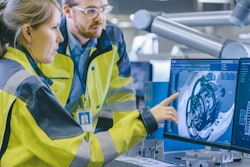
Even before the Coronavirus disease (COVID-19), attracting and retaining a qualified workforce often topped the list of challenges faced by distribution center (DC) operators. This challenge intensified after March 2020; just as COVID-19-driven competition for available labor was ramping up, the industry was seeing exponential spikes in adoption of e-commerce by brick-and-mortar retailers — also driven in part by the pandemic.
Fast forward to today and things have not changed much, and the continued effort to balance all these constraints while still maintaining productivity is keeping many of DCs awake at night.
The solution? Labor management software (LMS). While LMS has already proven itself as a solution for optimizing labor costs by enabling greater visibility and predictive planning, today’s platforms can also be used to incentivize employee engagement, lower attrition rates, shorten fulfillment time and reduce direct labor spend.
How LMS predicts future labor needs
During the last decade, the focus of LMS has shifted from interpreting the past to predicting the future. About 10 years ago, the insights it generated were limited largely to the previous day’s performance, highlighting which areas met their goals and which needed improvement. As LMS evolved, it became possible to get quick feedback about the previous shift or even iterative updates during the current shift. This data had value, but it mostly enabled only reactive responses to past results.
Today, with the advent of advanced machine learning algorithms, LMS can now use this historical data to predict a DC’s future labor needs. Recent advances in data science provide unprecedented levels of real-time data monitoring and predictive modeling. For example, a DC’s execution history can be used to predict its resource needs for the next day or even the next week, calculating the precise number of workers needed to operate at peak efficiency.
In a scenario like this, the LMS might notice that there are too many workers concentrated in one area, while another area will soon have a shortage. If the potential benefit of reassigning workers outweighs the opportunity cost of moving them, the system will automatically recommend an intra-day labor balance change. A similar strategy can be applied to product rather than workers, particularly at goods-to-operator stations or tote-picking areas. When too much product piles up, the sheer volume of work can create a psychological drain on workers that depletes their energy and reduces performance.
To prevent this effect, smart routing and release tools can optimize the flow of items throughout the entire material handling equipment infrastructure. This approach ensures that product is released into the system at the ideal time to keep the entire operation flowing efficiently, without creating physical congestion or psychological stress.
These capabilities are bringing game-changing insights to the supply chain. For example, LMS can also predict where each employee will work most effectively, which incentives will motivate them to get their job done, and whether they’re likely to quit in the next few weeks.
How LMS enhances employee safety and well-being
In the face of COVID-19-related labor management challenges, LMS has demonstrated its ability to address employee safety and well-being. By leveraging fundamental capabilities that have traditionally been focused on workforce productivity, DC operators are using LMS platforms to enhance worker safety in several ways.
· Influence employee behaviors. Beyond the usual pay-for-performance incentives, an LMS can monitor compliance with safety protocols, for example, distance between pick locations, time spent between shift transitions and use of personal protective equipment (PPE). The LMS documents infractions and assigns variables to help determine bonus awards or opportunities to improve. Over time, these incentives ingrain desired behaviors in the workplace culture, creating a self-regulating mechanism for continuous productivity and safety improvements.
· Track results. LMS platforms are based on engineered standards that provide a performance baseline that DC managers can use to monitor and measure key performance indicators. With LMS performance data, they can better assess the impacts of safety protocols on individual actions while setting productivity goals for employees that are realistic and achievable within the health protection standards.
· Encourage employee engagement. It helps ensure that employees are treated fairly and assigned achievable performance expectations, given the constraints created by new safety protocols. Any associates who put forth the extra effort to exceed baseline performance will be evaluated objectively and rewarded accordingly, encouraging continued behavior. LMS also helps DC managers identify individuals struggling to meet performance targets or adapting to new safety measures, creating the opportunity for quick intervention with a personalized coaching session.
How current market influences contribute to workforce pressures
Widespread retirement of baby boomers and a dearth of skilled younger workers continue to shrink the pool of qualified labor. Retention is also a major factor, with current estimates placing annual turnover for material handling and logistics positions at 25%. To compound the problem, skilled operational positions typically rely on on-the-job training, placing a premium on experience. When older employees retire, their legacy knowledge goes with them.
As the skilled labor pool dwindles, however, there is no corresponding reduction in demand, especially with the rise of omni-channel retail and the associated spike in direct-to-consumer orders. This forces DCs that were designed to stock brick-and-mortar retail floors to break down case and pallet loads and fill individual e-commerce orders, a more labor-intensive operation.
As this rocky transition continues, the push to raise fulfillment standards, shorten order-cycle times and improve accuracy rates has underscored the critical role of labor in driving customer satisfaction and earning repeat business.
As higher labor costs become an established piece of the puzzle, businesses strive to continuously improve employee performance and reap ever greater returns on workforce investment. Simply put, the concept of “business as usual” in DC operations has quickly become a thing of the past, replaced by a shifting retail market landscape and an influx of operational uncertainties.
How LMS can positively impact the employer
As one of its emerging benefits, LMS technology is enabling the ability to predict labor attrition. Modern LMS can forecast which individuals are most likely to quit next week and get it right 19 times out of 20. By drawing on years of historical data from facilities worldwide, machine learning algorithms can track employees from their start dates as they transition to new roles, quit, get laid off or let go. Once the model gains enough local data from a given site, it can identify factors that signal when a worker is at risk.
While predicting attrition isn’t exactly a crystal ball, early tests suggest the turnover of any given individual can be determined in advance with an accuracy of around 95% once the model has been programmed. Local data is key to this process -- what workers do differently before they quit can vary by organization and by location within the same organization.
The LMS needs only about six months to learn the patterns of an individual site. Once programmed, it can develop engagement models and incentives to retain and develop workers, creating measurable improvements for both employees and the DC. The same models can be used to pinpoint factors that are encouraging or discouraging employee retention, such as which supervisors are managing the largest number of satisfied employees and what their peers could be doing to improve their rates.
Looking forward
Creating a confident, healthy and engaged workforce helps build a culture that’s resilient to today’s dynamic market conditions. An LMS can help DC operators instill safe workplace practices, promote employee engagement, and drive continuous performance improvement through incentives and individual coaching. In doing so, they can avoid potential labor disruptions and give employees the confidence to reach peak performance levels.



















